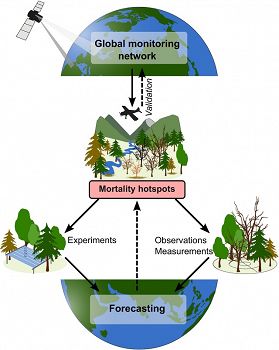Hartmann et al., 2018
Research frontiers for improving our understanding of drought‐induced tree and forest mortality
Hartmann, H., Moura, C.F., Anderegg, W.R., Ruehr, N.K., Salmon, Y., Allen, C.D., Arndt, S.K., Breshears, D.D., Davi, H., Galbraith, D., Ruthrof, K.X., Wunder, J., Adams, H.D., Bloemen, J., Cailleret, M., Cobb, R., Gessler, A., Grams, T.E., Jansen, S., Kautz, M., Lloret, F. and O'Brien, M. (2018)
New Phytologist 218(1): 15-28
-
Catalina-Jemez, INVESTIGATOR
Abstract
Conceptual framework for focused research on drought‐induced tree and forest mortality. A coordinated monitoring network that combines inventory plot data and satellite‐based remote sensing can provide information on changes in forest cover and identify potential hotspots of mortality. Mortality occurrences in these hotspots can be validated using aerial‐based remote sensing technologies like LiDAR. In these hotspots, investigations on the underlying physiological processes and ecological interactions through a combination of experimental manipulations and intensive field observations will provide mechanistic relationships allowing more realistic forecasting of forest conditions under anticipated future climate.
Accumulating evidence highlights increased mortality risks for trees during severe drought, particularly under warmer temperatures and increasing vapour pressure deficit (VPD). Resulting forest die‐off events have severe consequences for ecosystem services, biophysical and biogeochemical land–atmosphere processes. Despite advances in monitoring, modelling and experimental studies of the causes and consequences of tree death from individual tree to ecosystem and global scale, a general mechanistic understanding and realistic predictions of drought mortality under future climate conditions are still lacking. We update a global tree mortality map and present a roadmap to a more holistic understanding of forest mortality across scales. We highlight priority research frontiers that promote: (1) new avenues for research on key tree ecophysiological responses to drought; (2) scaling from the tree/plot level to the ecosystem and region; (3) improvements of mortality risk predictions based on both empirical and mechanistic insights; and (4) a global monitoring network of forest mortality. In light of recent and anticipated large forest die‐off events such a research agenda is timely and needed to achieve scientific understanding for realistic predictions of drought‐induced tree mortality. The implementation of a sustainable network will require support by stakeholders and political authorities at the international level.
Citation
Hartmann, H., Moura, C.F., Anderegg, W.R., Ruehr, N.K., Salmon, Y., Allen, C.D., Arndt, S.K., Breshears, D.D., Davi, H., Galbraith, D., Ruthrof, K.X., Wunder, J., Adams, H.D., Bloemen, J., Cailleret, M., Cobb, R., Gessler, A., Grams, T.E., Jansen, S., Kautz, M., Lloret, F. and O'Brien, M. (2018): Research frontiers for improving our understanding of drought‐induced tree and forest mortality. New Phytologist 218(1): 15-28. DOI: 10.1111/nph.15048
 This Paper/Book acknowledges NSF CZO grant support.
This Paper/Book acknowledges NSF CZO grant support.
Explore Further


